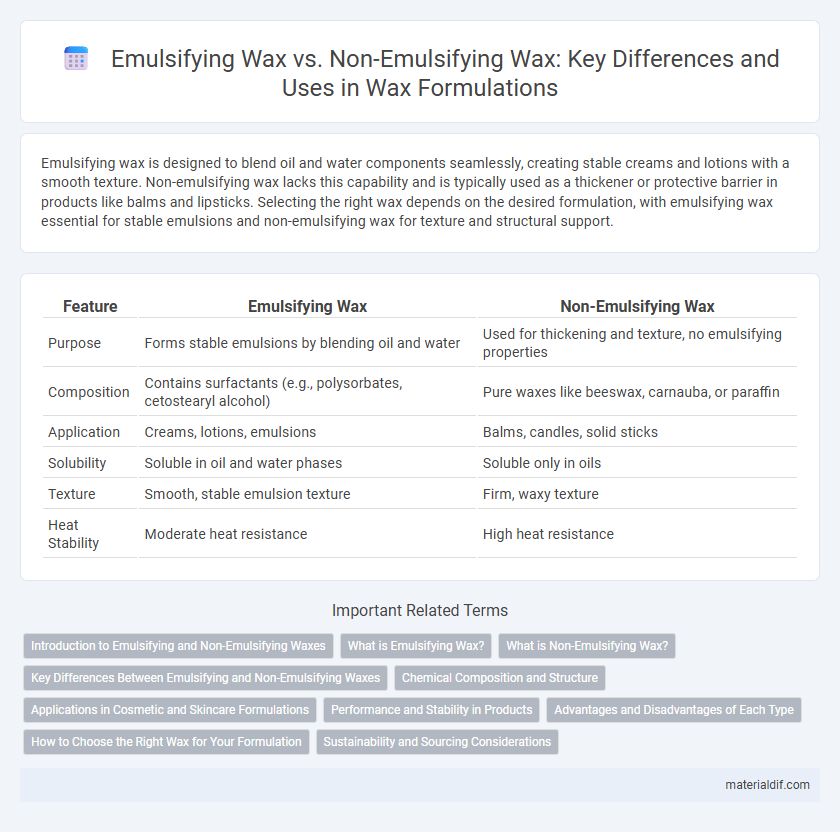Emulsifying wax is designed to blend oil and water components seamlessly, creating stable creams and lotions with a smooth texture. Non-emulsifying wax lacks this capability and is typically used as a thickener or protective barrier in products like balms and lipsticks. Selecting the right wax depends on the desired formulation, with emulsifying wax essential for stable emulsions and non-emulsifying wax for texture and structural support.
Table of Comparison
| Feature | Emulsifying Wax | Non-Emulsifying Wax |
|---|---|---|
| Purpose | Forms stable emulsions by blending oil and water | Used for thickening and texture, no emulsifying properties |
| Composition | Contains surfactants (e.g., polysorbates, cetostearyl alcohol) | Pure waxes like beeswax, carnauba, or paraffin |
| Application | Creams, lotions, emulsions | Balms, candles, solid sticks |
| Solubility | Soluble in oil and water phases | Soluble only in oils |
| Texture | Smooth, stable emulsion texture | Firm, waxy texture |
| Heat Stability | Moderate heat resistance | High heat resistance |
Introduction to Emulsifying and Non-Emulsifying Waxes
Emulsifying wax is a blend of fatty alcohols and esters designed to stabilize oil and water mixtures, forming uniform emulsions essential in lotions and creams. Non-emulsifying wax lacks such stabilizing properties and is primarily used to thicken or provide texture in formulations without blending water phases. Understanding the functional differences between emulsifying and non-emulsifying waxes is crucial for selecting the appropriate ingredient in cosmetic and skincare product development.
What is Emulsifying Wax?
Emulsifying wax is a blend of natural waxes and surfactants designed to bind oil and water components into a stable, uniform mixture, commonly used in creams and lotions. It acts as an emulsifier, creating smooth textures and enhancing product consistency by preventing ingredient separation. This wax is essential in cosmetic formulations requiring a stable emulsion, setting it apart from non-emulsifying waxes that do not blend oil and water phases.
What is Non-Emulsifying Wax?
Non-emulsifying wax is a type of wax used primarily as a thickening agent and protective barrier in cosmetic formulations without the ability to blend oil and water phases. Unlike emulsifying wax, it does not contain emulsifiers, making it ideal for oil-based products like balms, lipsticks, and ointments. Its hydrophobic properties enhance texture and stability while preventing moisture loss in skin care applications.
Key Differences Between Emulsifying and Non-Emulsifying Waxes
Emulsifying wax contains surfactants that enable it to blend oil and water phases, resulting in stable emulsions essential for lotions and creams. Non-emulsifying wax lacks these surfactants and primarily functions as a thickening agent or protective barrier in formulations without the ability to mix water and oil. The key difference lies in their emulsification capability, which determines their specific applications in cosmetic and pharmaceutical products.
Chemical Composition and Structure
Emulsifying wax consists of a blend of fatty alcohols and surfactants derived from natural oils, enabling it to form stable oil-in-water emulsions by reducing surface tension between oil and water phases. Non-emulsifying wax is primarily composed of long-chain hydrocarbons and esters, lacking surfactant properties and thus unable to create emulsions without additional emulsifiers. The chemical structure of emulsifying wax includes hydrophilic and lipophilic components that facilitate emulsification, whereas non-emulsifying wax maintains a purely hydrophobic character suitable for barrier formation and texture enhancement.
Applications in Cosmetic and Skincare Formulations
Emulsifying wax is indispensable in cosmetic and skincare formulations for its ability to blend oil and water phases, creating stable emulsions crucial for creams and lotions. Non-emulsifying wax, lacking this capability, is primarily utilized for its occlusive and texture-enhancing properties in balms, lipsticks, and protective barrier creams. The choice between emulsifying and non-emulsifying wax directly influences product stability, texture, and skin feel, impacting formulation outcomes in the beauty industry.
Performance and Stability in Products
Emulsifying wax enhances product performance by creating stable, homogenous blends of oil and water, essential for lotions and creams with consistent texture and improved shelf life. Non-emulsifying wax, lacking surfactant properties, primarily contributes to thickening and protective barriers but can result in phase separation in formulations. Stability in cosmetics heavily depends on the use of emulsifying waxes to maintain uniform dispersion and prevent ingredient separation over time.
Advantages and Disadvantages of Each Type
Emulsifying wax, primarily composed of fatty alcohols and ethoxylated compounds, offers superior stability in blending oil and water phases, ensuring smooth and consistent textures in creams and lotions. Non-emulsifying wax, often derived from natural sources like beeswax, excels in providing water-resistant barriers and enhancing product hardness but lacks the ability to uniformly mix oil and water components. The main advantage of emulsifying wax lies in its ability to create stable emulsions without phase separation, while its disadvantage can include sensitivity to high temperatures; non-emulsifying wax provides durability and water repellency but requires additional emulsifiers for effective formulation.
How to Choose the Right Wax for Your Formulation
Selecting the right wax depends on the desired texture and stability of your formulation; emulsifying wax is ideal for creating smooth, homogenous creams and lotions by blending oil and water phases, while non-emulsifying wax is suited for products where separation is not a concern, such as balms or lipsticks. Consider the solubility and melting point of each wax to ensure compatibility with active ingredients and processing conditions. Testing small batches helps determine the optimal wax type for achieving the intended consistency, stability, and performance in your cosmetic or skincare product.
Sustainability and Sourcing Considerations
Emulsifying wax, often derived from plant-based oils like coconut or palm and processed with sustainable practices, supports eco-friendly formulations by blending oil and water phases for biodegradable products. Non-emulsifying wax, typically sourced from beeswax or petroleum byproducts, may present environmental concerns related to animal welfare or fossil fuel dependency, affecting sustainability credentials. Choosing sustainably certified sources like RSPO-certified palm or organic beeswax enhances environmental responsibility in cosmetic and skincare formulations.
Emulsifying Wax vs Non-Emulsifying Wax Infographic

 materialdif.com
materialdif.com